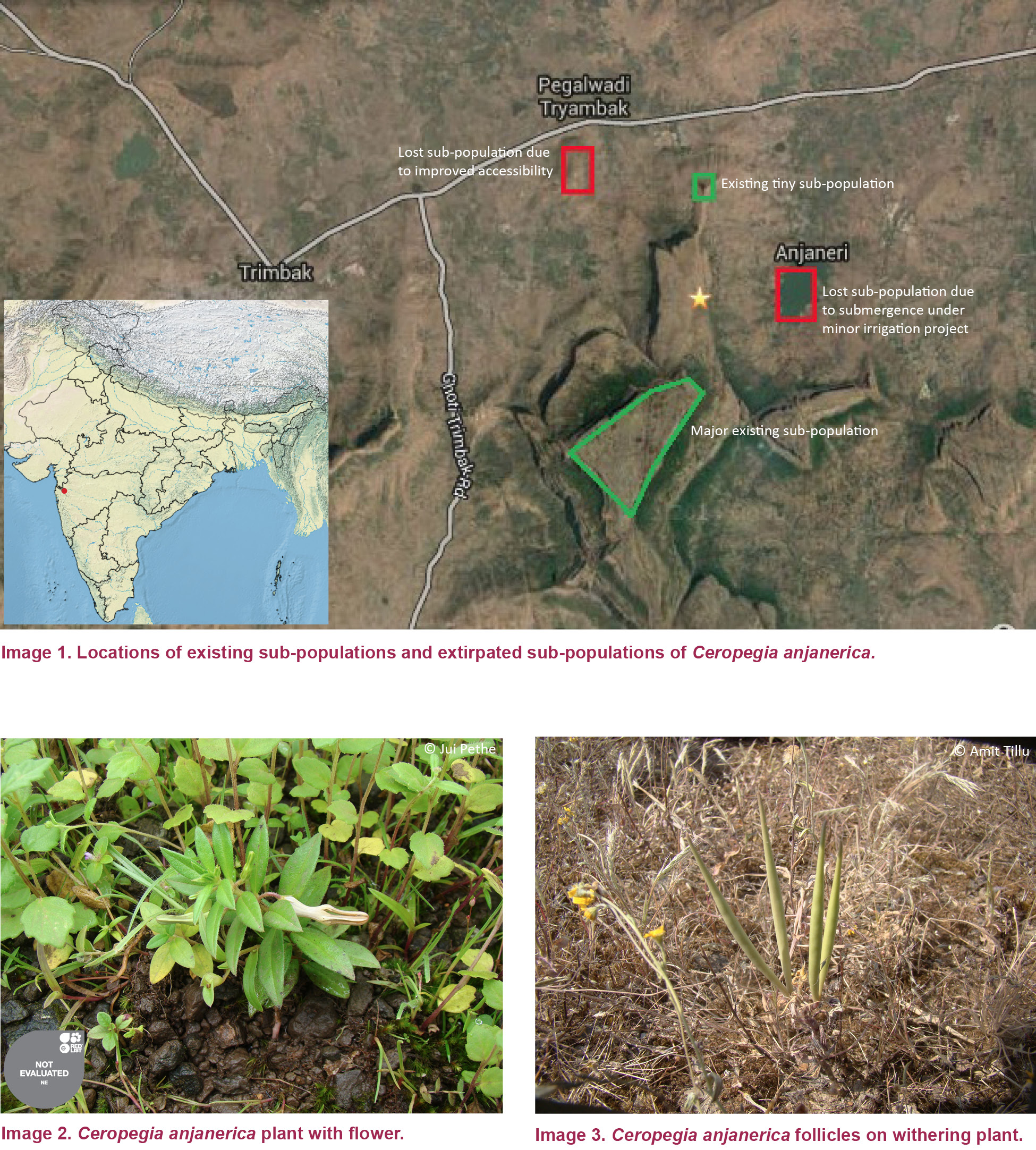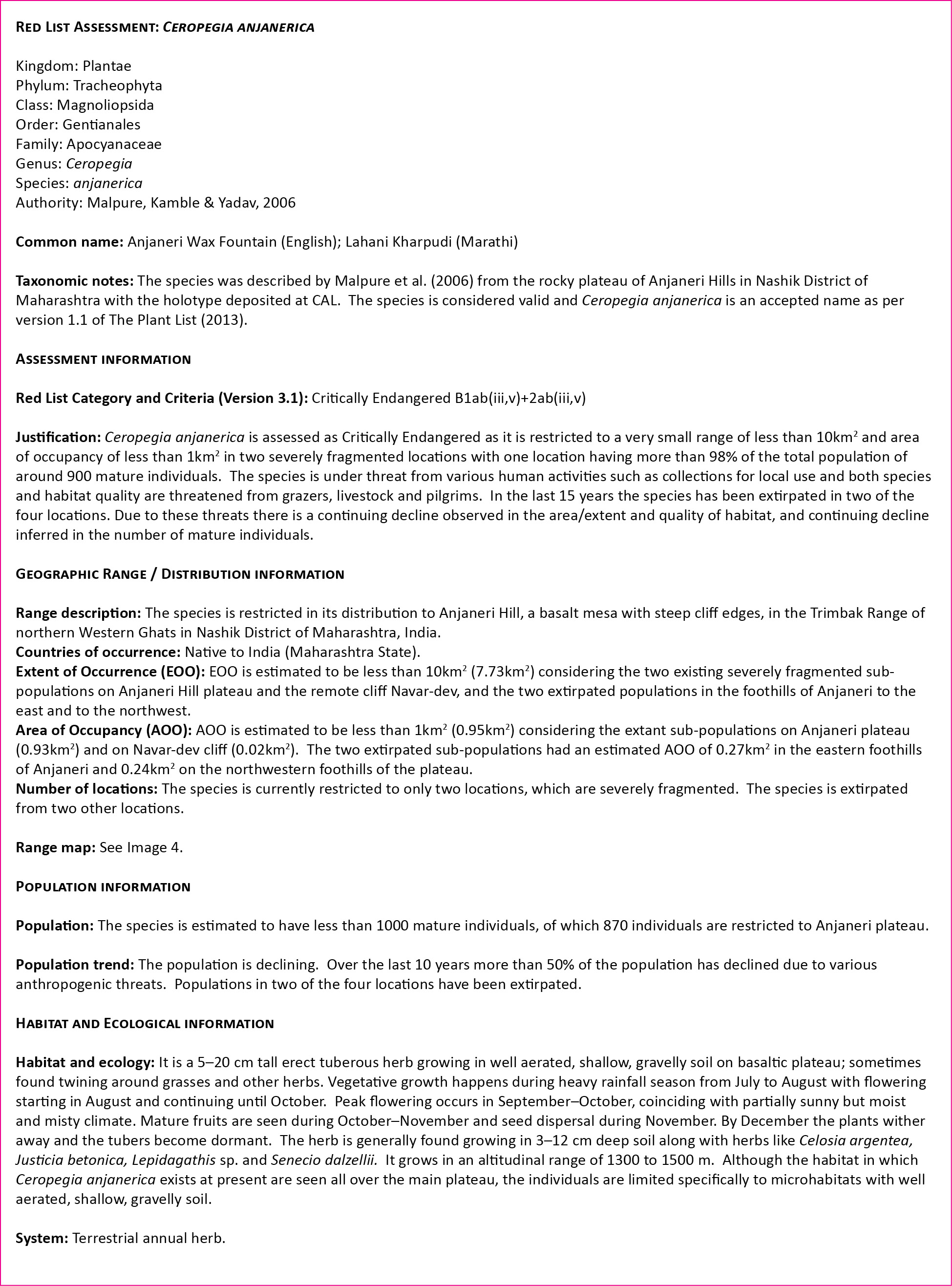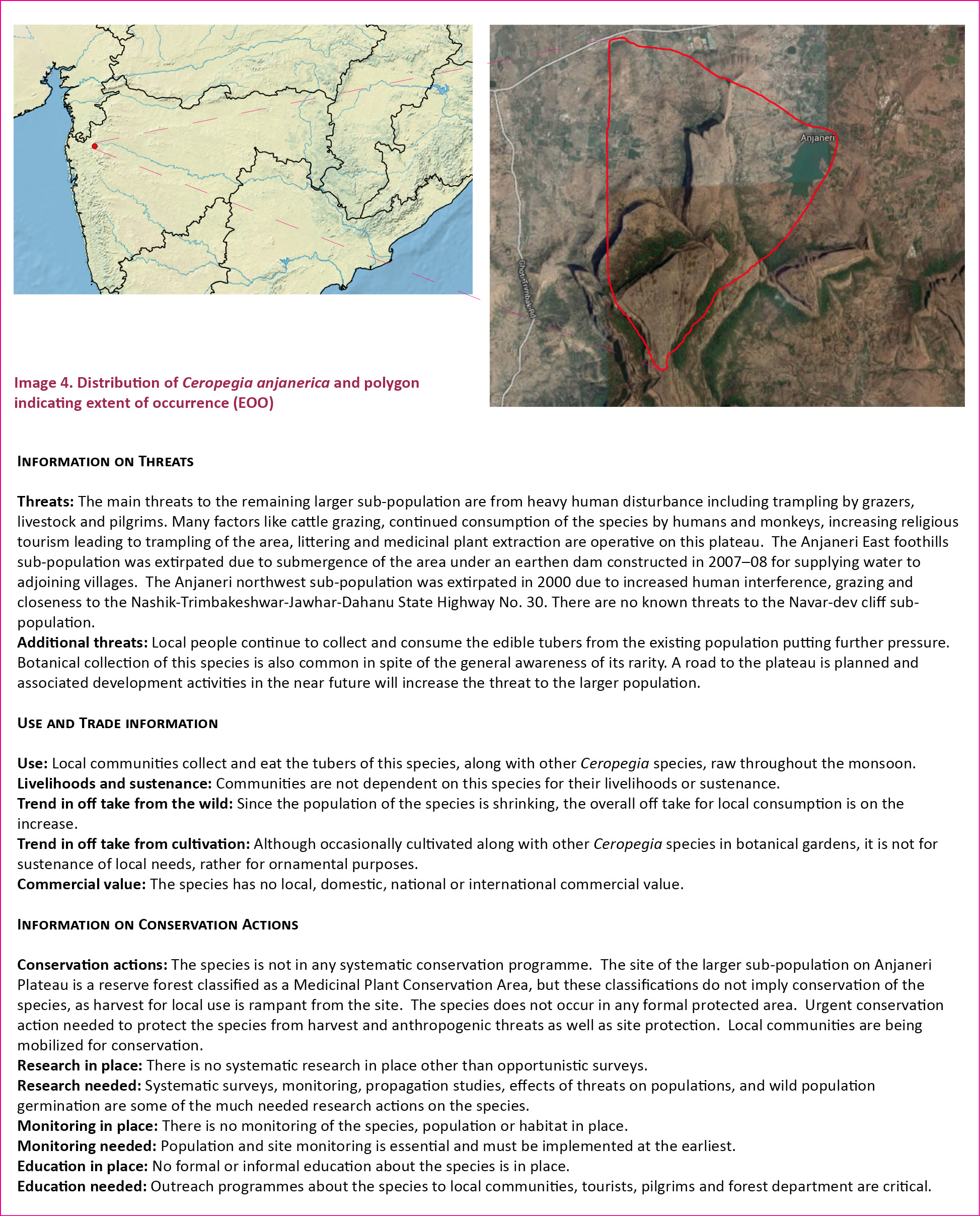Threat status assessment of Ceropegia anjanerica Malpure et al. (Magnoliopsida: Gentianales: Apocynaceae) from Anjaneri Hills, Nashik District, Maharashtra, India
Jui Pethe 1, Amit Tillu 2 & Aparna Watve 3
1,2 Shripad, Vakratund R.H, Opp. Rama Raman Apt., Vrindavan Nagar, Kamatwade, Ambad, Nashik, Maharashtra 422010, India
3 Biome Conservation Foundation, 34/6, Gulawani Maharaj Road, Pune, Maharashtra 411004, India
3 Present address: Tata Institute of Social Sciences, School of Rural Studies, Tuljapur campus, Tuljapur, Maharashtra, India
1 juipethe@gmail.com, 2 amittillu@gmail.com, 3 aparnawatve1@gmail.com (corresponding author)
doi: http://dx.doi.org/10.11609/JoTT.o3772.6965-71
Editor: B. Ravi Prasad Rao, Sri Krishnadevaraya University, Anantapur, India. Date of publication: 26 March 2015 (online & print)
Manuscript details: Ms # o3772 | Received 13 September 2013 | Final received 27 February 2014 | Finally accepted 02 March 2015
Citation: Pethe, J., A. Tillu & A. Watve (2015). Threat status assessment of Ceropegia anjanerica Malpure et al. (Magnoliopsida: Gentianales: Apocynaceae) from Anjaneri Hills, Nashik District, Maharashtra, India. Journal of Threatened Taxa 7(3): 6965–6971; http://dx.doi.org/10.11609/JoTT.o3772.6965-71
Copyright: © Pethe et al. 2015. Creative Commons Attribution 4.0 International License. JoTT allows unrestricted use of this article in any medium, reproduction and distribution by providing adequate credit to the authors and the source of publication.
Funding: The fieldwork was a part of the project ‘Herbarium Digitization & Identification Software Development for MPCA Anjaneri’ funded by the Deputy Conservator of Forest, West Nashik Division, Nashik Circle (2012-13). The third author was partially funded by CEPF-ATREE small grants programme CEPF-ATREE-WGhats/SGPIWGSG113_BIOME_Watve (2012-2013)
Competing Interest: The authors declare no competing interests.
Author Details: Jui Pethe is an ecologist working in Northern Western Ghats. She has worked with different NGOs and State forest department in exploring the floristic diversity of Nashik area. She has a societal research fellowship awarded by the DST and is working with Nature Conservation Society of Nashik. Amit Tillu is an organic farmer. He is active in studying the biodiversity of Nashik District and works with school children for science popularization and environmental awareness generation. Aparna Watve is an ecologist working in northern Western Ghats with special interest in rock outcrop ecology. She is currently at Tata Institute of Social Sciences, Tuljapur and studies and teaches about human-environment interactions.
Author Contribution: First and second author conducted detailed field studies, photodocumentation, participatory assessment and writing of the paper. Third author helped with analysis and writing the threat assesmment.
Acknowledgements: We take this opportunity to acknowledge the support provided by and offer thanks to Mr. Sai Prakash, Chief Conservator of Forest (Territorial), Nashik Circle, Deputy Conservator of Forest (DCF), Nashik West, Mr. Arvind Patil and Ms. Anita Patil for giving us an opportunity to study the species and area as a whole. They have enabled the unhampered, and smooth implementation of this project. Also we like to extend our gratitude to Mr. B. Raha, Honorary Wildlife Warden, Nashik for his constant support and encouragement in the work. We are grateful to Range Forester Mr. Rajan Gaikwad, Forestor Mr. Sonawane and Forest guard Mr. Wagh for their on-field cooperation and the villagers of Anjaneri for sharing their knowledge and experience about Anjaneri biodiversity.
Abstract: Ceropegia anjanerica is endemic to the Anjaneri Hills area of Nashik District. It is assessed as Critically Endangered as per the IUCN red list criteria using primary and secondary information on trends in EOO, AOO and sub-populations. Factors affecting this species and its habitat, and community conservation efforts are described and recommendations are made for its protection.
Keywords: Anjaneri, Anjaneri Wax Fountain, Ceropegia anjanerica, Critically Endangered, India, IUCN Red List assessment, northern Western Ghats.

Introduction
Ceropegia anjanerica Malpure, Kamble & Yadav, 2006, was described from the Anjaneri Hills in Nashik District. At the time of description, it was reported to have “about 100 individuals” based on observations in September 2005. Yadav & Kamble (2008) listed it as threatened, and described its status as “endemic to Maharashtra and Critically Endangered”. However, justification of the status was not provided. Population trend data, extent of occurrence (EOO) or area of occupancy (AOO) were not reported by Yadav & Kamble (2008). Observed, estimated, inferred or suspected decline in EOO, AOO or population size has not been reported until now. The species assessment was not compiled as per the IUCN guidelines and has not been reviewed. Hence, the species status remains unassessed on the IUCN Red List (IUCN 2013).
The species was known from only a single location, Anjaneri Hills, Nashik, which is under high biotic pressure such as cattle grazing, tourism and trampling, land use changes, etc. In view of this, detailed field studies were conducted for gaining more information regarding its status and trends in the wild. This paper presents a threat assessment of Ceropegia anjanerica based on primary and secondary data, and following the IUCN guidelines (IUCN 2013).
Methods
Anjaneri Hills is a reserved forest (RF) area and has been given the status of medicinal plant conservation area (MPCA) in 2009-2010. In July 2012, a floristic study project for Anjaneri Hills was started with the support of the state forest department, west Nashik, Maharashtra. Regular fortnightly visits were made to the Anjaneri Hills as a part of ongoing floristic studies of the area. Ceropegia anjanerica population was observed since the beginning of June 2012. During each visit individuals of this species were located and their geo-coordinates were obtained using a hand-held GPS (Garmin N72). The information reported here is based on field surveys from June 2012 to December 2012, spanning the entire growth period of Ceropegia anjanerica, covering all the stages from vegetative growth, flowering, fruiting to seed dispersal.
The plants in situ were shown to field forest department staff, Joint Forest Management Committee (JFMC) members from local villages and other villagers who frequently visit the area. During village meetings it was described along with photographs to all the villagers around Anjaneri Hills. The JFMC members and forest staff participated in the field survey and reported additional information used in this assessment.
Inquiries regarding the population of this species were also made in the neighbouring villages (Pahine, Pegalwadi, Kharoli, Talwade, Bramhanwade, etc) and with floristically knowledgeable individuals (e.g., shepherds, traditional healers in the community).
Semi-structured interviews were conducted for documenting its past and present occurrence in this region, growth, population trend and threats from the local people’s perception. Photographs of other Ceropegia species known to occur in the area (C. media, C. panchganiensis, C. oculata) were shown during discussions to check the local criteria for identification and accuracy level for identifying the target species C. anjanerica. Photographs of Ceropegia attenuata, the species morphologically closely allied to C. anjanerica (Malpure et al. 2006) were also shown. The primary and secondary information is used for the assessment based on IUCN Red List Categories and Criteria Version 3.1 and guidelines for assigning these criteria.
Results
Anjaneri Hill (19055’11.14”N & 73034’18.0”E) is a basalt mesa, a flat-topped hill with steep cliff edges. It is one of a cluster of five hills (Image 1), together known as ‘Trimbak Range’ of the northern Western Ghats. The topmost plateau of Anjaneri (1300m) can be approached by a steep climb from Hanuman-wadi hamlet of Anjaneri Village (680m), located 20km from Nashik City. Another extensive, plateau is present at 1100m along the northeastern ridge of the hill.
Ceropegia anjanerica is a 5–20 cm tall erect tuberous herb (Images 2–3) which is sometimes found to be twining around grasses and other herbs. Vegetative growth was seen in heavy rainfall season (July to August). Flowering initiated in August and continued till October. In 2012, peak flowering was seen during September–October, coinciding with partially sunny but moist and misty climate. Mature fruits were seen during October–November and seed dispersal took place during November. By December the plants had withered away and the tuber had become dormant.
The interviews indicated that the C. anjanerica is very well known to the local people who call it ‘Lahani Kharpudi’. All the local respondents could identify it with 100% accuracy as they collect and eat the tubers raw throughout the monsoon. During the field visits we also came across Bonnet Macaques and Hanuman Langurs consuming the tubers of C. anjanerica.

Villagers also identified C. panchganiensis with complete accuracy as its tubers and tender shoots are also collected and eaten. The respondents could identify Ceropegia media and C. oculata correctly and were able to point out individuals throughout the area in participatory visits, though they are not eaten. The respondents easily distinguished C. anjanerica from C. attenuata, and clearly stated that the C. attenuata does not occur anywhere in the region at present and had not occurred in the past. The ability to identify and distinguish between the different species of Ceropegia gives high credibility to the information provided by the respondents regarding its populations in the past and present.
Other species of Ceropegia like Ceropegia sahyadrica, C. vincifolia, C. media, C. bulbosa, etc. have been reported from the Borgad Hills, Trimbak, Brahmagiri Hills and slopes. But surveys and inquiries in these villages confirmed that C. anjanerica has never occurred in any of these hills.
Image 1 shows Anjaneri Hills with locations of sub-populations and EOO of Ceropegia anjanerica. A total of 870 individuals of Ceropegia anjanerica were located on the topmost Anjaneri plateau. They were generally found in 3–12 cm deep soil along with the clumps of herbs like Justicia betonica, Senecio dalzellii, Celosia argentea and Lepidagathis sp. No individuals were seen on the lower plateau of Anjaneri. Local respondents reported that the species is found on an adjoining cliff top (Image 1) called Navar-dev.
Ceropegia anjanerica at present occurs in two sub-populations, viz:
- Topmost plateau of Anjaneri (1200m): Number of mature individuals observed in 2012: 870, approximate AOO of sub-population = 0.93 sq.km.
- Top of a small cliff called ‘Navar-dev’ (19056’43.0”N & 73034’50.52”E) just adjoining the main Anjaneri cliff: The cliff is inaccessible except by technical climbing and not regularly accessed by local people. However, as a tradition, once a year, a skilled villager climbs it for certain rituals. The information of C. anjanerica presence is based on villager’s reports. The area extends to less than 2000m2. The sub-population occupies only a fraction (less than 0.25%) of the total AOO.
Though the habitat conditions in which Ceropegia anjanerica exists at present are seen all over the main plateau, the individuals are limited specifically to well aerated, shallow, gravelly soil. Local people state that the population of Ceropegia anjanerica on Anjaneri plateau has reduced drastically in the past 9–10 years. Many factors like cattle grazing, continued consumption by humans and monkeys, increasing religious tourism leading to trampling of the area, littering and medicinal plant extraction are operative on this plateau. Further autecological studies are necessary to understand the factors affecting the population and recruitment.
Local respondents added that 10–12 years ago, two more sub-populations occurred in the region (Image 1)
- Foothills of Anjaneri to the east (approx. 19056’11.15”N & 73035’23.65”E) (approximate AOO of sub-population = 0.27km2). This was submerged under an earthen dam constructed in 2007–08 for supplying water to the adjoining villages.
- Foothills of Anjaneri to the northwest (approx. 19056’49.86”N & 73033’57.58”E) (approximate AOO of sub-population = 0.24km2). This population has been lost since 2000. The possible reasons of loss stated by the local respondents were increased human interference, grazing and closeness to the Nashik-Trimbakeshwar-Jawhar-Dahanu State Highway No. 30.
Inquiries regarding Ceropegia anjanerica populations in surrounding villages (Pahine, Pegalwadi, Kharoli, Talwade, Bramhanwade) supported our observations that C. anjanerica is restricted only to the Anjaneri surroundings and is or was never present elsewhere.
The above discussion shows that the EOO of Ceropegia anjanerica has reduced by almost 60% and four sub-populations have now reduced to two sub-populations, of which one is very small. Increasing human interference of diverse nature is the primary cause. This phenomenon underlines and emphasizes the threats to this restricted species and the need to assign appropriate conservation status.
Threat Assessment: Information collected during the course of this study clearly indicates that Ceropegia anjanerica satisfies the criteria necessary for placing it in the Critically Endangered category (IUCN 2013) and is therefore considered to be facing an extremely high risk of extinction in the wild. Its EOO is currently approximately 7.73km2, main area of the hill top and adjacent cliff which is far less than 100km2, thus satisfying condition B1. The AOO is less than 1km2. Local communities have stated that there were four sub-populations some 15–20 years back. AOO then was a little less than 1.5km2. The current AOO is found to be less than 0.95km2. There is thus considerable reduction in AOO. The above mentioned facts satisfy the criteria for the Critical Endangered category B.
From the information of its past occurrence, the species was spread over a larger area of which only two sub-populations remain and is thus severely fragmented. The larger of the sub-populations is in an area of heavy human disturbance, such as trampling by grazers, livestock, pilgrims. A road to the plateau and development activities may come up in the near future increasing the threat to the larger population. The fate of the smaller population remains unknown. A continued decline has been observed in EOO, AOO, number of sub-populations and area, extent as well as quality of habitat as described above. Thus, it satisfies subcriteria a and b (2 of 3 as required). As seen from above, Ceropegia anjanerica fits both CR B1 and CR B2 criteria. We have chosen to designate its status based on EOO and AOO, which are clearly identifiable and quantifiable criteria, and can be measured for future monitoring of the species. Thus the status is Critically Endangered B1ab(iii,v)+2ab(iii,v).
Discussion
Ceropegia anjanerica population is larger than previously reported by Malpure et al. (2006). But two sub-populations have been lost in the past. The pressure of grazing cattle and trampling by tourists has been increasing at a constant rate according to local perception. Additionally, people continue to collect and consume the edible tubers from the existing population putting further pressure on existing resources. Recruitment has not been studied. Ceropegia genus is a horticultural curiosity and many other species have been widely collected from this area by plant enthusiasts and grown in private collections. Botanical collection of this Ceropegia species is also common in spite of the general awareness of its rarity.
A programme has been initiated with the help of the forest department and JFMC for generating awareness regarding special importance of this species and discouraging the over-exploitation of tubers. Members of JFMC and local forest guards and researchers have held village meetings and sensitization programmes for local people. An article has appeared in the local newspaper mentioning the restricted nature of Ceropegia anjanerica, urgency of conserving the species and its habitat and the need for public participation in the process. In spite of this, there has also been drastic increase in trampling due to tourism growth observed during the annual fair on Anjaneri. Many of the plateaux of northern Western Ghats are marked for windfarms. There has been already a request for creating a tar road to the temple on Anjaneri Hills. All these are serious threats which could drastically affect both the remaining sub-populations of C. anjanerica. The area harbouring this species also includes other rare, endangered and medicinal species of plants and animals. The present status of the site is reserved forest with the designation of MPCA. However, stronger measures along with involvement and awareness amongst the local community and visitors are required to protect the species in situ.
Conclusion
Ceropegia anjanerica is assessed as Critically Endangered (CR B1ab(iii,v)+B2ab(iii)) and requires urgent attention to stop further reduction in its population.
Based upon field observations, suggestions were made for the protection and control of plant resources from the area. The Forest Division (territorial) staff and JFMC of the Anjaneri Village initiated special protection measures since 2013 to limit overexploitation of plant resources from this area. There is an urgent necessity to continue this community initiative for long-term protection of this highly threatened species.
References
IUCN (2013). IUCN Red List of Threatened Species. Version 2013.1. <www.iucnredlist.org>. Downloaded on 07 July 2013.
Malpure, N., M. Kamble & S.R. Yadav (2006). A new species of Ceropegia L. (Asclepiadaceae) from the Western Ghats of India with a note on series Attenuatae Huber. Current Science 91(9): 1140–1142.
The Plant List (2013). Version 1.1. Published on the Internet; http://www.theplantlist.org/tpl/record/kew-2603917 (accessed 20 March 2015).
Yadav, S.R. & M.Y. Kamble (2008). Threatened Ceropegias of the Western Ghats and Strategies for Their Conservation, pp 123–134. In: Rawat, G.S. (ed.). Special Habitats and Threatened Plants of India. ENVIS Bulletin: Wildlife and Protected Areas, Vol. 11(1). Wildlife Institute of India, Dehradun, India.

